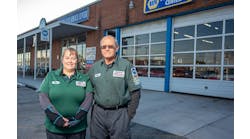Convenience is often one of the top things that attract customers to shops, and while a shop can’t be located near every customer’s home or work, it can provide pickup and delivery services to help make the customer’s life easier.
“My best anecdote is the very first day and the very first customer we picked up: She had called to cancel an appointment and our service advisor said, ‘If it’s easier for you, we can come get your car, service it and bring it back,’” says Scott Brown, owner of Cardinal Plaza Shell in Springfield, Va. “When I talked to her, she said, ‘I had an appointment but my 4-year old son has a fever and I couldn’t leave the house. If you didn’t have this service, I wouldn’t be able to come in today.’ I thought, ‘Bingo! It worked.’”
Brown has offered pickup and delivery services for drivable, non-tow-in vehicles at his shop for roughly a year now, and he says the value-added benefit has brought in an average of four new customers per week. At first glance, that may not sound significant, but that’s nearly an extra 100 customers every six months.
Although the service can be a great customer benefit, it can cause inefficiencies in the shop if you don’t have a proper setup. Brown and two other shop owners, who have successfully implemented their own vehicle pickup and delivery services, break down the most effective ways to do this without causing inefficiencies in the shop.
BENEFITS OF PICKUP AND DELIVERY
It’s easy to see why a customer would love the benefits of pickup and delivery services: It’s convenient, requires no work on the customer’s part, and allows them to get the vehicle repaired without taking any time out of their day.
For Brian Gillis, a regional manager for SRS and Co., veteran multiple-shop owner Greg Sands’ company, it’s all part of the company’s “yes” mentality of putting the customer first.
“It’s a great benefit for them,” he says. “I think it’s one of those extra added benefits that can help us outshine our competition.”
For example, Gillis, who oversees SRS & Co.’s America’s Service Station chain in Georgia, notes that this is especially helpful for assisting elderly or handicapped customers, who may experience more difficulty bringing their vehicles into the shop. Other customers may experience an odd noise with their vehicles and are scared to drive the cars themselves.
It can be a great tool for capturing business from customers who may have objections or are calling around, he says.
“Sometimes people just want to come in and get an estimate and they may not have any intentions of taking any immediate action,” Gillis says. “When we tie in the benefits and one of them is that we offer free pickup and delivery, it takes away that objection that they don’t have time to bring it in right now. That’s the end of them calling around.”
Jeff Van Sant, owner of Pella Car Care in the rural town of Pella, Iowa, agrees.
“We try to be the one-stop shop,” he says. “There are two new car dealers in town and they are my main competitors. I felt like I needed to at least match, if not exceed, the dealer level of service. Customers love it. It has been 100 percent positive.”
CREATING AN EFFICIENT PROCESS
There are many ways to implement a pickup and delivery service, which can vary depending on your shop, staff size and capacity. Although Brown, Gillis and Van Sant all run their services differently, all three agree on a number of considerations every shop owner should make to efficiently set up the service:
1. Purchase loaner vehicles. Brown purchased two Chevrolet Sparks to use as the designated pickup vehicles, while Van Sant has a fleet of 12 loaner vehicles—which he slowly accumulated over time—that are used for pickup and delivery and as straight loaners. They both branded the vehicles with the shop’s logo, phone number and website to make them easily identifiable.
Van Sant says the loaner vehicles serve a number of purposes: They act as marketing for the shop; allow the customer to have access to a vehicle while theirs is in the shop, especially if the repair should unexpectedly take longer than a day; and mean that vehicle pickup and delivery only requires one person to leave the shop.
2. Decide the staffing. The biggest obstacle to running a pickup and delivery service efficiently is staffing: No matter what, at least one person will be out of the shop. Brown, Gillis and Van Sant have all found different models for staffing the service.
Brown uses his shuttle driver to act as the designated pickup and dropoff driver. He says that if a shop has a designated driver, the most important attribute is what he calls a “zero creepiness factor.”
“You have to be polite,” he says. “That’s really reassuring for the customer.”
He has also trained his driver on every aspect of the shop and its specials so that he acts as a representative for the company. Generally, either Brown or a service advisor will ride along in the vehicle and drive one of the vehicles back to the shop. If the shop is too busy, the driver will ride alone and simply leave one of the loaner vehicles with the customer.
Gillis, on the other hand, utilized existing staff and added the task to the job descriptions of the managers and the general service team. Each general service team member acts as a “jack-of-all trades” in the shop: They perform emissions testing, assist the technicians, drive the shuttles, and do any janitorial work necessary. Gillis says that a requirement for that position is a clean driving record. That way, when a pickup or delivery is needed, any member of the team can go out.
“We just have a staffing level that we keep our folks on staff to where we can always accommodate our features and benefits when they come in,” he says. “It does take two people and it’s going to be wherever there is the lightest load at the time. We’re always prepared with our staff on hand to do those service requests when they pop up.”
Finally, Van Sant kept a now-retired staffer on part-time to help pick up cars in the morning. Due to the extensive loaner fleet, doing so only requires one person, as he leaves the loaner vehicle in its place. In the afternoon, Van Sant says either he or a service advisor will deliver the vehicle and pick up the loaner vehicle.
No matter what the staffing model is, it’s important to talk to your insurance agent and make sure anyone who will drive the vehicles is covered.
3. Stay Organized. All three shop owners agree: The key to implementing the service effectively is staying organized. Know your limits and don’t exceed what your staff can handle.
“When we schedule work, our car count is about 25 cars a day,” says Van Sant. “Half of those cars will get picked up or the people will get loaners. Several of the others would get a ride from our shuttle. We count how many of those we are doing in a day, as far as pickup and delivery plus loaners, and we try not exceed about 10 a day.”
Brown created a spreadsheet that lists all of the pickups and dropoffs and where the vehicle is at any particular time. When a customer calls to make an appointment and requests the service, he will note it in the spreadsheet, make sure it doesn’t overlap with an existing pickup, and ask for a 30-minute window of time to arrive at the destination. Before delivery, he says the shop will collect payment over the phone and then leave a copy of the invoice in an envelope on the front seat.
Similarly, Van Sant created a large whiteboard with every car listed, the customer’s name and the delivery time and date.
“We can just glance up at the wall and see that something has to be delivered by 3 p.m. and raise the question,” he says.
The bottom line, they agree, is to create a standard process so that everyone knows how to schedule the service, where the vehicles are, and how to collect payment.
MAXIMIZE THE SERVICE
Brown says that after implementing the service, it took off slowly—until he started marketing it. Besides branding the loaner vehicles, he also created a landing page on his website and built a Google AdWords pay-per-click campaign around the service. He also created cards and took them around to local businesses, explaining the services. He says that marketing was the key in turning it from one pickup and delivery every day to around five to seven.
“We probably have an additional just 10 dropoffs,” he says. “A lot of times, they’ll want to drop it off but will ask to have it delivered when it’s done. I didn’t anticipate that. However they want to use it, I figure that we’re there to help them however they want to be helped.”
Van Sant says he took advantage of relationships he had with two of the largest employers in his town and is now in those parking lots every day picking up and delivering vehicles.



